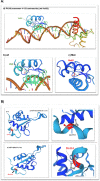Variants in PAX6, PITX3 and HSF4 causing autosomal dominant congenital cataracts
- PMID: 34345029
- PMCID: PMC9307513
- DOI: 10.1038/s41433-021-01711-x
Variants in PAX6, PITX3 and HSF4 causing autosomal dominant congenital cataracts
Abstract
Background: Lens development is orchestrated by transcription factors. Disease-causing variants in transcription factors and their developmental target genes are associated with congenital cataracts and other eye anomalies.
Methods: Using whole exome sequencing, we identified disease-causing variants in two large British families and one isolated case with autosomal dominant congenital cataract. Bioinformatics analysis confirmed these disease-causing mutations as rare or novel variants, with a moderate to damaging pathogenicity score, with testing for segregation within the families using direct Sanger sequencing.
Results: Family A had a missense variant (c.184 G>A; p.V62M) in PAX6 and affected individuals presented with nuclear cataract. Family B had a frameshift variant (c.470-477dup; p.A160R*) in PITX3 that was also associated with nuclear cataract. A recurrent missense variant in HSF4 (c.341 T>C; p.L114P) was associated with congenital cataract in a single isolated case.
Conclusions: We have therefore identified novel variants in PAX6 and PITX3 that cause autosomal dominant congenital cataract.
© 2021. Crown.
Conflict of interest statement
The authors declare no competing interests.
Figures



References
MeSH terms
Substances
Supplementary concepts
LinkOut - more resources
Full Text Sources
Medical
Molecular Biology Databases

